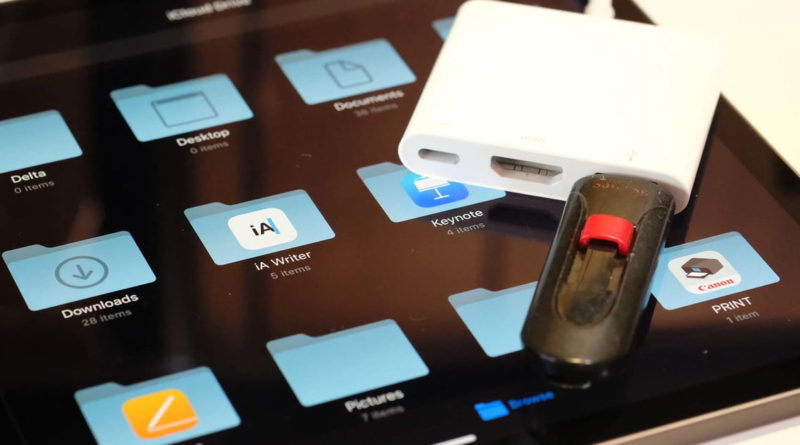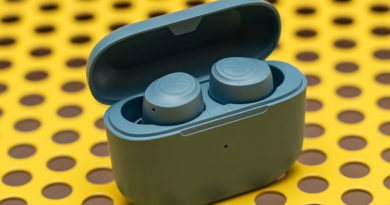How to Use External Storage With an iPhone or iPad
[ad_1]
Despite Apple’s proprietary Lightning connector on its iPhones and most of its iPads, owners can still access files stored on an external drive. Apple made this possible with the release of iOS 13 in 2019, adding native support for external storage devices using both Lightning and USB-C connectors. Interested? This guide shows you how.
Verify your device has iOS 13 or newer

To gain native compatibility with external storage devices, your iPhone or iPad will need iOS 13 at the very least. However, not all devices are compatible with the latest versions of iOS and iPadOS. If it can’t upgrade beyond iOS 12, then you can’t use an external storage device.
Every device that could update to iOS 13 or iPadOS 13 can also update to iOS 14 or iPadOS 14, so you can check out our list of iOS 14 and iPadOS 14 compatible devices to see whether your device qualifies. Also, keep in mind that anything released since iOS 14 or iPadOS 14 was released will support the latest versions of the Apple mobile operating system.
If you have a compatible device but you’re not sure which version of iOS / iPadOS it’s running, here’s how to check:
Step 1: Tap to open the Settings app.
Step 2: Scroll down and tap General.
Step 3: Tap About.
On the following screen, check the number next to Software Version. If it’s lower than 13, move on to the next step. If it’s version 13 or higher, move to the next section of this guide.
Step 4: Return to the General screen in the Settings app.
Step 5: Tap Software Update.
Step 6: If an update is available, tap Download and Install. If your device is already up to date, it will state as such, along with the current version installed.
Understanding Lighting versus USB-C

Before plugging an external device into your iPhone or iPad, it is essential to understand which connector is available to you.
Apple introduced its Lightning port in 2012 as part of the company’s goal to make the iPhone slimmer. It’s smaller than the now more-common USB-C introduced two years later. In fact, Apple was part of the overall USB-C design process. However, Lightning and USB-C are two completely separate technologies.
For one, Apple’s Lightning port is slimmer than USB-C, perfect for iPhones and iPads. The connector, flatter in design, has exposed pins, whereas a USB-C connector encloses the pins. Meanwhile, Lightning can handle roughly up to 12 watts of power, likely more, whereas USB-C supports up to 100 watts of power. All modern iPhones and most modern iPads have the Lightning port, with exceptions for the latest iPad Pro and iPad Air models.
Use the photograph above for assistance in recognizing the two ports. Apple’s Lightning port is thinner and appears hollow, while the USB-C port is slightly thicker and has a slim connector in its center.
Physically connect your external device

Before unlocking your iPad or iPhone and jumping into the software, we need to establish a physical connection between your external storage solution and your tablet or smartphone. If your iPhone or iPad and external device have matching plugs, connect both by plugging them into one another using the bottom connector of your Apple device.
For example, a thumb drive might also use a Lighting connector, allowing it to plug directly into iPhones and most iPads. Or, an external hard drive might use a USB-C connector, allowing it to plug directly into iPad Pro devices. Otherwise, if the connectors are different, you will need to purchase an adapter so that your external device can connect to your iPad or iPhone.

If you have an Apple device with a Lightning connector and need to plug in an external device with either a USB-C or USB-A connector, one option is Apple’s Lighting to USB 3 Camera Adapter. Ignore the name, however, as this adapter allows you to plug more than just external USB-C and USB-A camera devices into your Apple device.
If you have an Apple device with a USB-C connector, such as the iPad Pro, and need to plug in an external device with a USB-A connector, Apple sells a USB-C to USB adapter.
Browsing files from your external device

Once your external device is physically connected to your Apple device, you can use the native Files app to access the external device.
Step 1: Tap to open the Files app on your iPhone, iPad, or iPod Touch.
Step 2: Under Locations, tap the name of your external drive. In this example, it’s simply labeled Drive.
On the iPad, the contents of your external device appear on the right. On iPhones and the iPod Touch, the contents appear on the following screen.

Step 3: Tap any folder or file with your finger to open it. Alternatively, hold down with your finger on any visible folder or file to open a submenu and get additional management options, including copying, duplicating, moving, deleting, renaming, tagging, and favoriting.
Note: To select multiple files or folders, tap the Select option in the upper-right corner, and then tap each file or folder you wish to manipulate.
If you can’t access your storage device

If you’re having issues accessing files on a connected storage device, give these few options a try before abandoning your quest.
Check the connection
Double-check that your devices are correctly plugged in together with the appropriate plugs and adapters. Try different adapters or cables if you have the option.
Check the drive’s file format
Ensure that your external storage device is formatted so that Mac and iOS devices may read it. For example, the standard NTFS file format, commonly used by Windows, is not supported by the system. Both platforms support exFAT, but this format only supports files up to 4GB.
Check the power requirements
See if your external device requires too much power. Solid-state drives, hard drives, and some other devices may need more power than your iPhone or iPad can output.
Consult Apple
If you are still having issues connecting your external storage device, reach out to Apple with your concerns. Free support is available via the company’s in-store Genius Bars and the Apple Support app.
Editors’ Recommendations
[ad_2]
Source link




